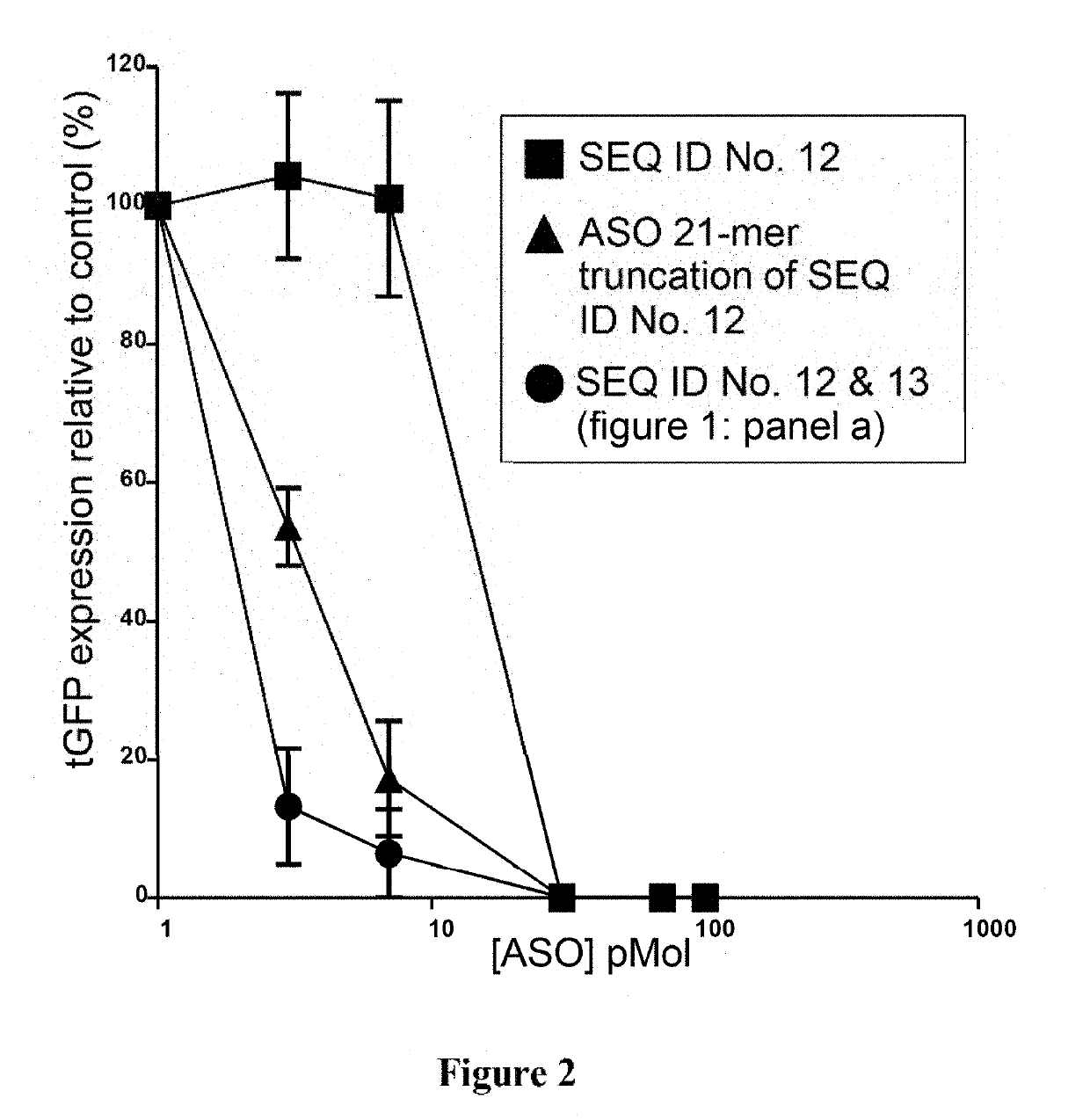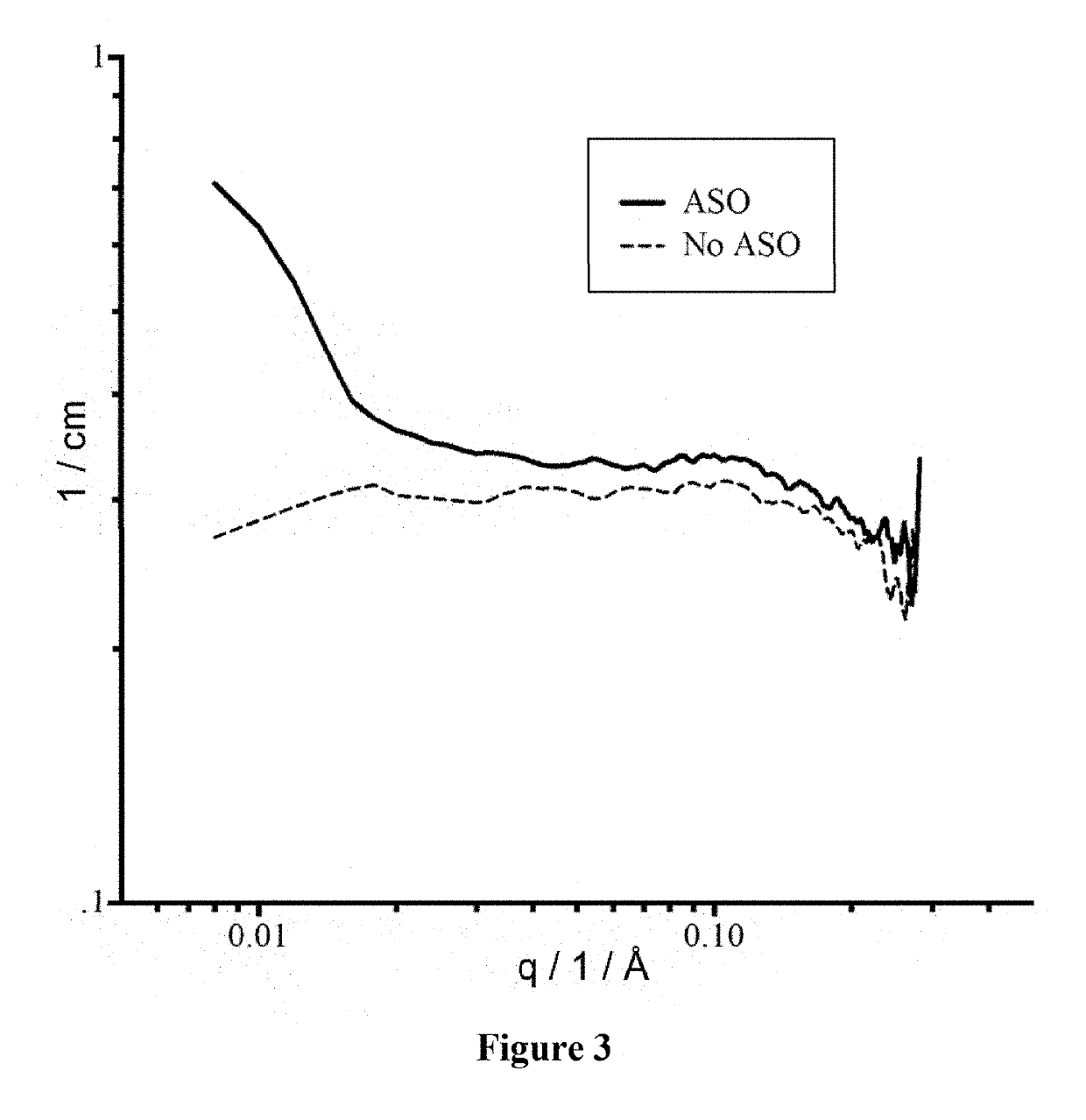Antisense oligonucleotide compositions
a technology of antisense oligonucleotides and compositions, which is applied in the direction of drug compositions, antineoplastic agents, biochemistry apparatus and processes, etc., can solve the problems of insufficient safety or reliability in the clinic, limited bioavailability, and inability to achieve the effect of facilitating the cytosolic delivery of antisense agents
- Summary
- Abstract
- Description
- Claims
- Application Information
AI Technical Summary
Benefits of technology
Problems solved by technology
Method used
Image
Examples
example 1
of Shuttle Protein
[0049]LFn-GAL4 was enriched from cultures of E. coli with a yield of approximately 5 mg / l. The DNA sequence coding for the protein LFn-GAL4 is SEQ ID No: 4 (FIG. 9). This sequence is within the plasmid pET151 / D (Invitrogen), an E. coli expression cassette.
[0050]The DNA sequence for LFn (LF domain 1) and GAL4 (amino-acids 1-147) (known in the art—Gaur et al., 2002) was sub-cloned into the pET151 / D bacterial expression cassette. The addition of a V5 epitope tag at the N-terminus and 6× histidine affinity tag at the C-terminus allowed for the rapid immunodetection and affinity purification, respectively, of the fusion protein from bacterial lysate.
[0051]Recombinant protein production: Chemically competent bacteria (E. coli BL21*DE3 (Invitrogen)) were transformed with purified plasmid (described above) and cultured overnight (10 mL) in 2× yeast extract tyrptone (2×YT) bacterial culture, containing ampicillin (200 μg / ml) media prior to sub-culturing in large volumes (1 ...
example 2
n of Pore-Forming Protein
[0052]PA83 was enriched from cultures of E. coli BL21*DE3 with a yield of approximately 5 mg / l. A plasmid containing the known DNA sequence encoding PA83 was obtained as a gift from Professor Les Baillie (University of Cardiff). It contained the PA83-encoding sequence sub-cloned into the bacterial expression vector pQE30 providing an N-terminal 6× histidine affinity tag (Baillie et al., 2010). Chemically competent bacteria were transformed with purified plasmid and cultured overnight as before. During the growth phase, the 1 l bacterial cultures were incubated in an orbital shaker set at 180 rpm (at 37° C.) for 3 hours. Subsequently IPTG was added to a final concentration of 500 μM and incubated for a further 2 hours. Bacterial pellets were prepared by centrifugation (6 000×g for 10 min) and subjected to lysis using a French Press as before. Bacterial lysates were subjected to further centrifugation (20 000×g for 20 min). The resultant supernatant was passed...
example 3
of Antisense Oligonucleotide with Double-Stranded Protein-Binding Region
[0054]Two complementary oligonucleotides, each encoding one strand of a GAL4 recognition sequence, were annealed, to form a double-stranded (GAL4) protein-binding sequence with flanking single-stranded antisense sequences. The ASO compositions described (SEQ ID Nos: 8 & 9: see Example 4) were used in this instance. The resulting composition is shown in FIG. 1a. Antisense oligonucleotide hybridization was performed by repeated (×10) thermal cycling, melting (1 min. at 94° C.) and re-annealing (1 min. at 55° C.) the two partially overlapping oligonucleotides, leaving single-strand antisense oligonucleotide sequence free to interact with mRNA in a sequence-specific manner.
[0055]FIGS. 1a-1e show several possible topologies of the protein-binding (DS) sequence of DNA (or DNA analogues) in relation to the antisense nucleic acid sequence(s) using the protein::oligonucleotide conjugation strategy disclosed herein. FIG. ...
PUM
| Property | Measurement | Unit |
|---|---|---|
| radius of gyration | aaaaa | aaaaa |
| concentration | aaaaa | aaaaa |
| volumes | aaaaa | aaaaa |
Abstract
Description
Claims
Application Information
 Login to View More
Login to View More - R&D
- Intellectual Property
- Life Sciences
- Materials
- Tech Scout
- Unparalleled Data Quality
- Higher Quality Content
- 60% Fewer Hallucinations
Browse by: Latest US Patents, China's latest patents, Technical Efficacy Thesaurus, Application Domain, Technology Topic, Popular Technical Reports.
© 2025 PatSnap. All rights reserved.Legal|Privacy policy|Modern Slavery Act Transparency Statement|Sitemap|About US| Contact US: help@patsnap.com



